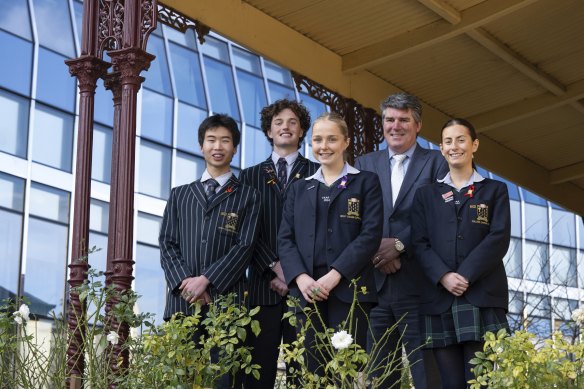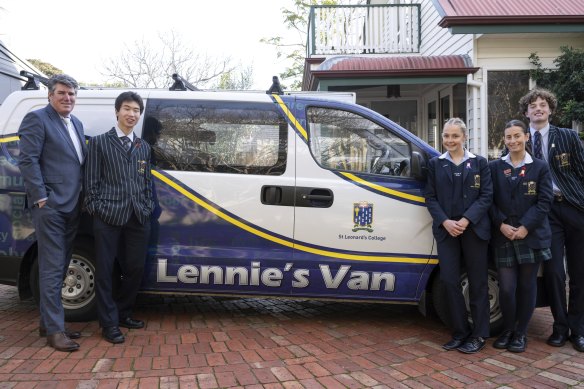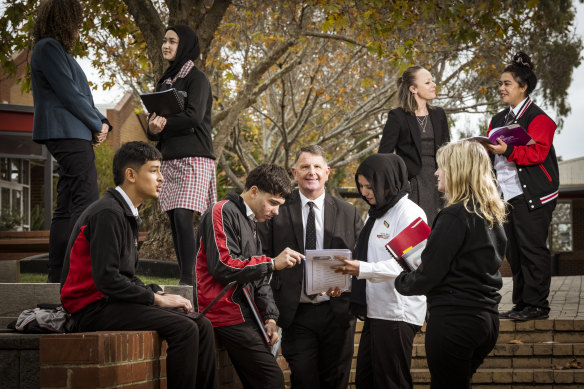By Bridie Smith
Ask the students at St Leonard’s College their favourite thing about school and they will probably tell you it’s Lennie’s Van.
The compact blue and white van with yellow racing stripes and retractable side awning travels around the public housing estates in the suburbs surrounding the school’s East Brighton campus.

St Leonard’s College principal Peter Clague with Richie Huang, Spencer Hawkins, Emily Conheady and Nicola Ioschiavo.Credit: Penny Stephens
Students in years 10 to 12 volunteer to deliver fruit and bread as well as make breakfast, lunch or afternoon tea for residents.
Seats in the van, which makes five outings a week, are booked out within an hour of being released each term.
“It’s like getting tickets to a concert,” year 12 student Emily Conheady says of the thrill of securing a spot aboard the van, which has been doing the rounds since 2018.
“When I get asked about what I do at school, I don’t talk about the classes or the camps, but Lennie’s Van.”

St Leonard’s College principal Peter Clague with student volunteers who rode in Lennie’s Van to prepare breakfast for residents at a local council estate.Credit: Penny Stephens
For proud 10-time Lennie’s veteran and IB student Richie Huong, the value is two-fold.
“You get to do it with your friends and meet people. And they are in our community, they are in bayside.”
Lennie’s Van is so popular that middle-year students started a vegetable garden to grow fresh produce for delivery to public housing residents, principal Peter Clague says.
“This college has a heart for social action,” Clague says.
In his eyes, it’s what sets the independent, co-educational school in Melbourne’s south-east apart.
In 2023, a year after he started as principal, Clague appointed a full-time social responsibility coordinator. That year, the school – which offers both VCE and the International Baccalaureate – got rid of academic and cultural scholarships in favour of scholarships for students from Indigenous, refugee or disadvantaged backgrounds.
“It’s not hurt us in terms of academic or sporting success,” Clague says.
St Leonard’s College has just been awarded The Age’s 2024 Schools that Excel independent school winner for Melbourne’s south for the improvement its VCE results have shown over the past decade.
The annual series celebrates schools that achieve outstanding advancement in their VCE results.
You can explore a decade of VCE results data for your high school and view the full list of winning schools using this year’s Schools that Excel dashboard:
The school’s students recorded a decade-high median VCE study score of 35 last year, compared with 33 in 2013. In addition, more than 20 per cent of its VCE study scores were 40 or above, its best performance in 20 years on this metric and up from 2014 when 12.4 per cent of its study scores were 40 or above.
Clague said that among International Baccalaureate students, the median ATAR last year was 96, with 83 per cent of students getting an ATAR of 90 or above, compared with a decade earlier when the median ATAR was 95.5, with 80 per cent of International Baccalaureate students getting an ATAR of 90 or above.

Hampton Park Secondary College Principal Wayne Haworth, centre, with assistant principals Andrea Bellgrove, back left, and Kelly Krieg, back right, and the school and house captains.Credit: Chris Hopkins
At Hampton Park Secondary College, raffle tickets have been the secret to boosting student engagement and attendance.
Students who arrive before roll-call go in the running to win anything from books to sports equipment.
Those with an attendance record of 98 per cent and higher also receive certificates at assembly. Currently, certificates have been given to 900 students out of the school population of 1200.
Principal Wayne Haworth says rewarding attendance is just as important as recognising the most improved students or the high achievers.
“It builds engagement and if you’re engaged, you’re more likely to want to learn,” he says.
It’s a core belief echoed by assistant principal Kelly Krieg. “Coming to school is a road to success,” she says.
Year 12 student Josh Chhean admits one of the best things about coming to school is the chance to use the 3D laser printers. But he, too, can see the bigger picture.
“When I am around friends, I feel motivated. When they’re studying, I study,” he says.
Improved student attendance and engagement are reflected in the school’s improved academic results, which have seen it named The Age’s 2024 Schools that Excel government school winner for Melbourne’s south.
The school’s median VCE study score has risen steadily over the past decade, lifting from a 10-year low of 24 in 2014 to its best result of 29 last year. In 2023, 2.1 per cent of study scores were 40 or above compared to 1.5 per cent in 2014.
“Often in low socioeconomic communities, there is a feeling that ‘you can’t’. But you can. We know that. Every student can,” Haworth says before heading out to do yard duty.
with Craig Butt
Start the day with a summary of the day’s most important and interesting stories, analysis and insights. Sign up for our Morning Edition newsletter.